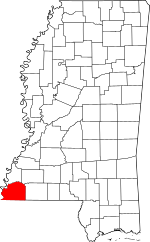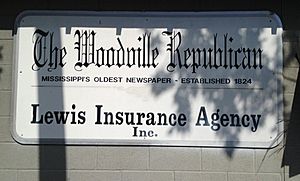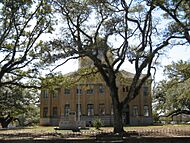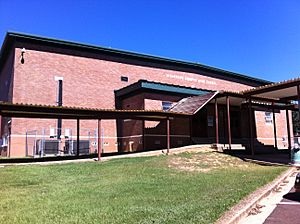Wilkinson County, Mississippi facts for kids
Quick facts for kids
Wilkinson County
|
|
|---|---|
|
Left to right: Clark Creek and Wilkinson County Courthouse
|
|

Location within the U.S. state of Mississippi
|
|
 Mississippi's location within the U.S. |
|
| Country | |
| State | |
| Founded | 1802 |
| Named for | James Wilkinson |
| Seat | Woodville |
| Largest town | Centreville |
| Area | |
| • Total | 688 sq mi (1,780 km2) |
| • Land | 678 sq mi (1,760 km2) |
| • Water | 9.7 sq mi (25 km2) 1.4% |
| Population
(2020)
|
|
| • Total | 8,587 |
| • Density | 12.481/sq mi (4.819/km2) |
| Time zone | UTC−6 (Central) |
| • Summer (DST) | UTC−5 (CDT) |
| Congressional district | 2nd |
Wilkinson County is a county located in the southwest corner of the U.S. state of Mississippi. As of 2020, its population was 8,587. Its county seat is Woodville. Bordered by the Mississippi River on the west, the county is named for James Wilkinson, a Revolutionary War military leader and first governor of the Louisiana Territory after its acquisition by the United States in 1803.
Contents
History

In the nineteenth century, this county was developed by European-American settlers as cotton plantations along the Mississippi River, which forms the western border of the county. Much of the bottomlands and interior were undeveloped frontier until after the American Civil War. The intensive cultivation depended on the labor of numerous enslaved African Americans; in the early nineteenth century, more than a million were transported here from the Upper South in a major forced migration. The population of this county quickly became majority black as workers were brought in.
The West Feliciana Railroad was later built to help get the cotton commodity crop to market. Some planters got wealthy during the antebellum years and built fine mansions in the county seat of Woodville, Mississippi. After the Civil War, freedmen and planters negotiated new working arrangements, and sharecropping became widespread.
A long agricultural depression affected the economy. The peak of population in the county was reached in 1900, after which many blacks left in the Great Migration to the North and Midwest, to escape the racial segregation and disfranchisement suffered here since passage of the state's new constitution in 1890 and later Jim Crow laws.
In the early 20th century the boll weevil infestation destroyed much of the cotton crops, and mechanization caused a further loss of agricultural jobs. Timber has been harvested and processed as a new commodity crop. The population of the rural county has continued to decline. Towns have started to develop heritage tourism to attract more visitors.
Geography
According to the U.S. Census Bureau, the county has a total area of 688 square miles (1,780 km2), of which 678 square miles (1,760 km2) is land and 9.7 square miles (25 km2) (1.4%) is water.
Major highways
Adjacent counties
- Adams County (north)
- Franklin County (northeast)
- Amite County (east)
- East Feliciana Parish, Louisiana (southeast)
- West Feliciana Parish, Louisiana (south)
- Concordia Parish, Louisiana (west)
National protected area
- Homochitto National Forest (part)
Demographics
| Historical population | |||
|---|---|---|---|
| Census | Pop. | %± | |
| 1810 | 5,068 | — | |
| 1820 | 9,718 | 91.8% | |
| 1830 | 11,686 | 20.3% | |
| 1840 | 14,193 | 21.5% | |
| 1850 | 16,914 | 19.2% | |
| 1860 | 15,933 | −5.8% | |
| 1870 | 12,705 | −20.3% | |
| 1880 | 17,815 | 40.2% | |
| 1890 | 17,592 | −1.3% | |
| 1900 | 21,453 | 21.9% | |
| 1910 | 18,075 | −15.7% | |
| 1920 | 15,319 | −15.2% | |
| 1930 | 13,957 | −8.9% | |
| 1940 | 15,955 | 14.3% | |
| 1950 | 14,116 | −11.5% | |
| 1960 | 13,235 | −6.2% | |
| 1970 | 11,099 | −16.1% | |
| 1980 | 10,021 | −9.7% | |
| 1990 | 9,678 | −3.4% | |
| 2000 | 10,312 | 6.6% | |
| 2010 | 9,878 | −4.2% | |
| 2020 | 8,587 | −13.1% | |
| 2023 (est.) | 8,058 | −18.4% | |
| U.S. Decennial Census 1790-1960 1900-1990 1990-2000 2010-2013 |
|||
Population
Wilkinson County had a population of 8,587 people, 3,170 households, and 1,843 families at the 2020 United States census.
Race
| Race/ethnicity | Num. | Perc. |
|---|---|---|
| White | 2,525 | 29.4% |
| Black or African American | 5,764 | 67.12% |
| Native American | 16 | 0.19% |
| Asian | 8 | 0.09% |
| Other/Mixed | 204 | 2.38% |
| Hispanic or Latino | 70 | 0.82% |
According to the U.S. Census Bureau, Wilkinson County's racial and ethic makeup was predominantly Black and African American in 2020. The total racial and ethnic composition at the 2020 census was 67.12% Black and African American, 29.4% non-Hispanic white, 0.19% Native American, 0.09% Asian, 2.38% multiracial or other race or ethnicity, and 0.82% Hispanic or Latin American of any race.
Income
In 2010, the American Community Survey estimated the county had a median household income of $28,066. At the 2020 American Community Survey, its median household income increased to $30,760; the median monthly housing costs were $419. In 2020, the county had a mean income of $46,538, and married-couple families had a median income of $50,227 while non-family households averaged $27,468.
Education
Wilkinson County School District serves the county. Prior to 1970, when a federal court ruling forced the schools to integrate, the county maintained a separate and highly inferior educational system for Black students. When the schools were finally integrated, all but two white students initially chose to attend Wilkinson County Christian Academy, which was established in 1969 as a segregation academy, or other private schools rather than attend school with Black students. Barnard Waites, the superintendent of the public school system sent his own child to Wilkinson County Christian Academy, and harshly criticized the white parents who exposed their children to the "all negro environment" of Wilkinson County Training School.
Wilkinson County is in the district of Southwest Mississippi Community College.
Communities
Towns
- Centreville (partly in Amite County)
- Crosby (partly in Amite County)
- Woodville (county seat)
Unincorporated communities
Ghost towns
Notable people
- Regina Barrow (born 1966), Louisiana state senator from Baton Rouge, Louisiana, since 2016; former state representative from 2005 to 2016; native of Wilkinson County
- Jefferson Davis, President of the Confederate States of America; grew up at Rosemont plantation just east of Woodville
- Anne Moody (1940-2015), civil rights activist and author
- Edward Grady Partin (1924–1990), Teamsters Union business agent in Baton Rouge, native of Woodville
- William Grant Still, African-American classical composer and Mississippi Musicians Hall of Fame inductee was born in Woodville in 1895
See also
 In Spanish: Condado de Wilkinson (Misisipi) para niños
In Spanish: Condado de Wilkinson (Misisipi) para niños




